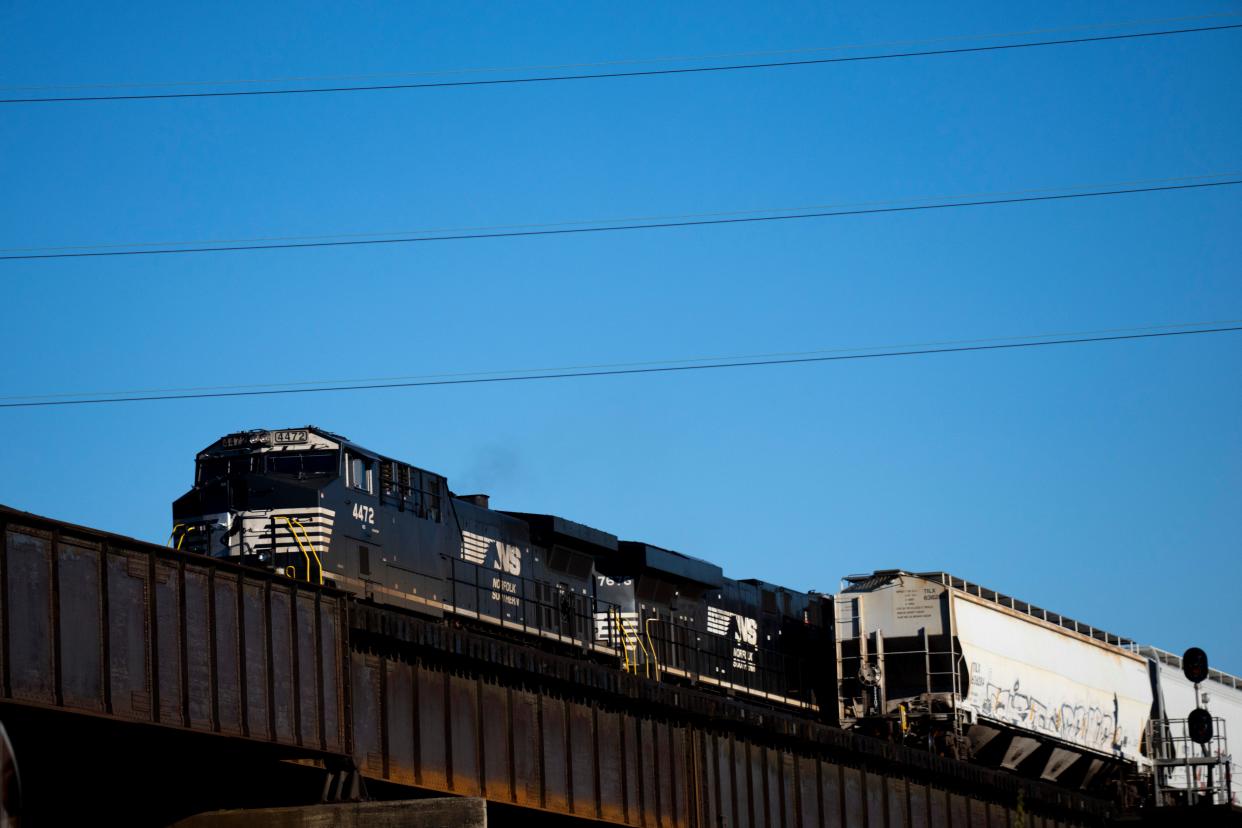Opinion: Don't rush to sell city-owned railroad

Something smells about the proposed sale by the City of Cincinnati of the Southern Ohio Railway to Norfolk Southern Corp., and it isn’t the diesel fumes from a locomotive. Cincinnati should not sell one of our city’s greatest income-producing assets on the terms approved by the Cincinnati Southern Railway Board. It is not only unnecessary but it puts the finances of Cincinnati at risk in the long term.
Unanswered questions
Is the Railway a tremendous asset for the city? Yes. Do we know how much the railway is actually worth? No.
Does the city need funding to restore failing infrastructure? Yes. Will the city use this funding to fix our infrastructure? Not necessarily.
Does the city need to sell the railway to create the funding stream to restore our infrastructure? No.
How did we get here?
The city is doing this backwards. Cincinnati is the only city in the country owning an interstate railroad, pursuant to state legislation from the 1800s. Changes to this legislation will only affect Cincinnati.
The current lease was entered into in 1987. That first year of the lease, the city was paid $11 million. The rent payments have gone up each year and in fiscal year 2023 are projected to be $23,730,668. The city uses these payments either for repayment of bond indebtedness, repayment of short term capital indebtedness, or current capital expenditures. In the approved capital budget for fiscal 2023, the rent from the railway was 43 percent of the total general capital revenue.
Negotiations concerning the sale of the railway have been going on since at least early in 2021. The proposed sale did not become public knowledge until late November, as a proposed change in state law began to be discussed among our local representatives and senators.
Current state law and the current lease provide that the trustees may only modify the lease “in accordance with ordinances of the council of the city.” There are no ordinances directing the trustees of the railway to sell the railway. The proposed change to state law would reverse this procedure and allow the unelected trustees to enter into a sale agreement and determine how much of the sales proceeds (or income derived from the proceeds) is to be “transmitted to the [City].”

Changing state law
The Ohio Senate finished its session at 6 a.m. on Dec. 15 and thanks to dogged determination by a few senators, in the face of immense pressure, the changes to state law did not occur … yet. The sale agreement signed by the board anticipates that the “lame duck” change in the law might not occur and anticipates a time frame that could extend into 2025. Proponents of the proposed law change point out that any sale would still be subject to a vote of the people of Cincinnati. What they don’t point out is that Norfolk Southern is required under the sale agreement to “pay all costs related to its supporting efforts for obtaining Cincinnati voter approval and shall make payments directly to such third parties … to assist in obtaining such approval.” This one sentence is very telling. Not only does Norfolk Southern think that a sale for $1.6 billion is a good deal for them, they are going to spend additional millions to promote the required vote to approve the sale.
How much will the city receive from the sale
As word of the sale got out, the city quickly called a press conference announcing the proposed sale on Monday, Nov. 21. At the press conference, it was indicated that the minimum annual payment would not be less than the current rent payment. I certainly hope not since the current rent payment is far less than the fair market rent for the railway.
At the press conference, it was indicated that it is “estimated” that the purchase price would bring in around $56 million per year, or 3.5 percent of the $1.6 billion purchase price. The city is giving up the assurance of a bonded rent payment that should bring in a minimum of $64 million in its first year, increasing each year of the remaining lease term to keep up with inflation (as does the current lease) in exchange for investment of the money by the unelected Board of Trustees.
What will the city spend the money on?
Although there would no longer be a railroad owned by the city, the proposed change in state law would retain the unelected Cincinnati Railway Board of Trustees to control the investment and disbursement of the proceeds to the city. The prosed legislation is vague enough that it could be used for a lot of things other than fixing the city’s existing capital assets.
Buried in the language for uses, the funds may be used for “… modernization, or replacement of…existing streets, …, municipal buildings, …, site improvements, …, and any other public facilities owned by [Cincinnati].” This language is broad enough to drive a railroad through. The word “existing” only modifies "streets," and the money could be used for new buildings, facilities, and site improvements, etc. as long as they are owned by the city at the time the trustees decide to release the money for "site improvements." Transfer of ownership to the city to take advantage of favorable financing is not a new or fanciful phenomenon, it happens all the time.
The wish list for using this money is longer than the railway. It could be used for a new indoor arena, or expansion of the convention center, or covering Fort Washington Way, or redoing our existing stadiums, or expansion of the streetcar, all while the roads in Bond Hill, Westwood, Sayler Park, Mount Washington, (insert your neighborhood here), continue to deteriorate and the decisions on what to spend the money on and how much to spend are made by an unelected and unaccountable Board.

Determining the value of the railway
It is clear, through records I obtained through public records requests, that the parties differed greatly in their respective opinions of value. Southern Ohio Railway is 337 miles long, stretching from the Cincinnati to Chattanooga, Tennessee, and is the linchpin in the railway networks of Norfolk Southern. The public and, according to Cincinnati’s city solicitor, our elected officials, and our state representatives and senators, do not have access to the appraisals obtained by the board. It is inconceivable to me that our current mayor, former mayors, and state legislators are supporting this proposed transaction without knowing how much the railway is worth.
Appraisals are often used to estimate the fair market value of real estate. Any appraisal of the railway would be highly speculative and would necessarily have to include the unique role that Cincinnati’s railway plays in the operation of the entire system.
Although at one point, Norfolk Southern threatened to walk away and reroute their existing use through other networks. Although not impossible, such a threat should, at a minimum be viewed skeptically, given that they have used Cincinnati’s Railway for the past 150 years and Norfolk Southern raised its offer by over $500 million after making this threat.
Our nation depends on the railways of the country to effectively and efficiently move the agricultural goods, coal and oil, and other products that all of us need every day. Interruption of freight rail is estimated to cost our country $1 billion dollars per day. The dependence of our country on our railways was just recently used by the federal government to intervene in the labor dispute between railroad worker unions and the railway companies. Rail is so important to our country that the Biden administration and a bipartisan vote of Congress made it illegal for the rail unions to strike because of the adverse economic and public safety effects a strike would have on the country.
Appraisals
Appraisals are as much an art form as a science. As the students from my quarter century of teaching real estate transactions at the University of Cincinnati College of Law can tell you, there are three primary methods of appraising real property: comparable sales approach; cost approach; and the income capitalization approach.
In valuing railroad corridors, a method called “Across the Fence” methodology is sometimes used, and purportedly was the method employed by Norfolk Southern in its initial offer. This method may be appropriate for excess railway by applying the value of adjacent land, but is completely inappropriate for an operating line that is not easily replaceable.
The comparable sales approach won’t work because there aren’t any comparable sales. Railroads just aren’t sold very often and certainly, railways that are so essential to the operation of an entire railway system are not sold. Even abandoned rail lines are extremely valuable. In 2016, Cincinnati paid Norfolk Southern $11.8 million for 4.1 miles ($2,878,000 per mile) of unused railway to provide land for the Wasson Way bike trail. 337 miles of essential, operating rail would be much more valuable on a per mile basis than this.
The cost approach is also not of much utility. The cost of buying appropriate land across three states and constructing a new railway would be astronomical. The cost of the Cincinnati Streetcar was in excess of $135 Million for 3.2 miles of railway and did not include land costs.
The income capitalization approach would be the most appropriate method for determining the fair market value of the railway if there were a long term lease in place. There isn’t. The current lease expires in 2026, and the 25 year option to extend the lease does not include a rental amount.
How much could the city receive in rent?
The railway is already a passive investment of the city. In real estate terminology, the lease between the city and Norfolk Southern is known as a triple net, or true net lease. The lease provides that Norfolk Southern Railway “will pay and save harmless (Cincinnati) from the payment of any costs, expenses, claims, liabilities, damages and demands whatsoever arising out of… (Norfolk Southern‘s) possession, control, management and operation of the … railway … or any part of the leased premises.” This means that Cincinnati has no obligations related to the railway, all of which obligations are the responsibility of Norfolk Southern. In simpler terms, the railway is an investment of the city, similar to what the trustees want to use the proceeds of the sale for, but not subject to market fluctuations and loss.
Determining a new rent amount
Importantly, the rent to be paid to the city for the renewal term of the lease, if not agreed to between the parties, is to be determined by non-binding arbitration. If the city is not satisfied with the decision reached in the arbitration, it may lease or sell the railway to a third party, subject to the right of Norfolk Southern to match the offer.
At the very least, putting the railway on the open market would give Cincinnati a better idea of the fair market value of the railway, as it would open the process to other railroads as well as third-party investors and equity funds. If the city is insistent on selling the railway, this would give the city a better idea of the true value of the railway.
There is no question that the current lease payments do not reflect fair market rent of the railway. Although we don’t know the fair market value of the railway, we do know that it is at least $1.6 billion dollars because that is the amount that Norfolk Southern has agreed to pay. Since the city has no responsibilities under the lease (other than collecting the rent payments), utilizing the income capitalization method and assuming a conservative amount for annual rent of 4% of the value, the city would receive rent of $64 million in the first year of the renewal term of the lease (with annual escalation of the rent based on inflation) – and the city would retain ownership of the railway.
Don't sell valuable assets unnecessarily
As then candidate and later Mayor John Cranley stated in 2013, when there was a proposal to sell Cincinnati’s parking operations, Cranley called the plan a “snow job“ and said that the city would be selling a valuable asset unnecessarily. We should heed Cranley’s advice from 2013.Protecting a vital source of income for our city is of the utmost importance to the city and shouldn’t be done in back rooms and without the ability of the people to even see the data behind these decisions. Keep ownership of the railway, increase the rent paid to the city, fix our roads, parks, and recreation centers, and open the doors and let some air in by showing us the information. Otherwise, it just doesn’t smell right.
Kevin Flynn lives in Mount Airy and is a former Cincinnati councilman.

This article originally appeared on Cincinnati Enquirer: Cincinnati Southern Ohio Railway sale proposal column Flynn

